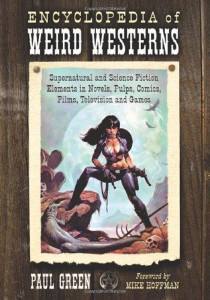 Craig Clarke wrote this review.
Craig Clarke wrote this review.
Traditional Westerns offer some of the best reading around, but an enthusiast also appreciates a blending of genres now and then. Westerns with crime fiction tropes are fairly easy to find; that’s just your average historical mystery with a different setting. But what about tales of the Old West that have horrific or supernatural elements? For that, you have to go to the “Weird Western.”
But once one has decided to pursue more of this obscure subgenre, where do you find it? Apart from coming across one accidentally, or finding the rare like-minded individuals to offer recommendations, it is hard to know where to look. Luckily, author Paul Green has solved that problem for the time being with his Encyclopedia of Weird Westerns.
From the beginning it is clear that Green has an affection for his work. In the preface, he states that the Encyclopedia “covers the history of [the genre, dating] back over 150 years.” But he also warns that the reader will not find only classics within, that the quality “ranges from top-class and innovative to repetitive and formulaic,” and that he has not left out works that “might be considered in bad taste or offensive. The weird by definition attracts the weird.”
Green has compiled hundreds of titles and authors of (and characters from) Weird Western stories, novels, movies, TV shows, comics, video games, and more. He covers the gamut from the only slightly weird to the truly odd, from early dime novels to current role-playing games, dividing them all into six basic categories: the Weird Western (with horror and fantasy elements), the Weird Menace Western (supernatural events with a rational explanation), the Space Western (“cowboy with a ray gun” – probably the most popular with the mainstream, it includes such favorites as Burroughs’s John Carter series, Star Wars, Firefly, and the recent Avatar), the Science Fiction Western (future technology, aliens, or post-apocalyptic themes – Green includes a very thorough rundown of The Wild, Wild West), the Steampunk Western (incorporating Victorian technology), and the inevitable Weird Western Romance (which is fairly self-explanatory; it seems every genre has its “romance” offshoot).
Most surprising to this reader, all ages of reader are represented, from the Indian in the Cupboard books and Four Feather Falls TV series for children, to the Djustine comic books for adults, a combination of the Marquis de Sade and the spaghetti Western that details the “sexually graphic adventures of the large-breasted female gunslinger and her fight with the supernatural including zombies, vampires and Diabla, daughter of Satan.” (I can hear the keyboards tapping into search engines already. That’s one sure thing about Weird Western enthusiasts: the more outlandish it is, the better we like it.)
Given Green’s experience as a comics artist (Marvel UK, DC Egmont, Golden Books USA) and a TV historian (A History of Television’s The Virginian), it’s not surprising that the Encyclopedia of Weird Westerns focuses more on visual media than on more traditional stories and novels – though it could simply be a case of “weirdness” being more acceptable in visual form. Green even makes sure to include Western-centered episodes of otherwise non-Western TV shows, like Sabrina, the Teenage Witch, Highlander, and Star Trek: The Next Generation (you’ve got to love that holodeck!).
It is very easy to get lost in the Encyclopedia of Weird Westerns, so make sure to set aside a good deal of time when you pick it up to “just look something up.” There are plenty of discoveries awaiting, and some old favorites to revisit. I’m sure some favorites have been inevitably omitted (the one I noticed was Steve Vernon’s zombie buffalo novella Long Horn, Big Shaggy), but even Green is aware of this. As a supplement, he has created a blog, also called Encyclopedia of Weird Westerns, where he posts news and reviews of more recent titles. [Update: Alas, this blog seems to no longer be available.] Jump on the robotic-horse-drawn stagecoach and ride into the world of the Weird Western.
(McFarland & Company, 2009)
